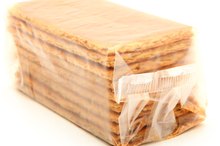Crackers spread with cream cheese can be a tasty snack, but they may not necessarily supply you with very much nutrition. The nutrition in this snack depends on what type of cream cheese and crackers you choose. Knowing the nutrition information can help you toward making the most nutritious choice when you prepare a snack of crackers with cream cheese.
Fat
Small serving sizes can be deceiving. You may think that a tablespoon of regular cream cheese wouldn't be able to pack in much fat, but the suggested 1 tbsp. serving contains 50 calories and 5 g of total fat. Those calories and fat can really add up if you want a big snack. Moreover, much of the fat in regular cream cheese is saturated. A diet high in saturated fat has been linked to an increased risk of heart disease and obesity. If you plan on making yourself a plate of cream cheese and crackers, choose low-fat cream cheese because it contains less than half the fat as regular.
- Small serving sizes can be deceiving.
- If you plan on making yourself a plate of cream cheese and crackers, choose low-fat cream cheese because it contains less than half the fat as regular.
Calcium
How Many Calories Are in Frozen Yogurt Compared with Ice Cream?
Learn More
Cream cheese, like other diary foods, contains calcium, a nutrient you need for healthy bones and teeth. Choosing low-fat cream cheese is not only smart in terms of fat and calories, but it will also supply you with more calcium than regular cream cheese. A 1 tbsp. serving of low-fat cream cheese supplies you with 22 mg of calcium while regular cream cheese has 14 mg.
- Cream cheese, like other diary foods, contains calcium, a nutrient you need for healthy bones and teeth.
- Choosing low-fat cream cheese is not only smart in terms of fat and calories, but it will also supply you with more calcium than regular cream cheese.
Fiber
Foods made with whole grains supply dietary fiber. Some crackers have more fiber than others and choosing whole grain crackers can also improve the nutritional value of your snack. Five regular snack crackers have less than half a gram of fiber while a serving of whole wheat snack crackers contains 3 g of fiber. A diet rich in fiber contributes to digestive health and may also help cut the risk of certain health conditions such as heart disease.
- Foods made with whole grains supply dietary fiber.
- Some crackers have more fiber than others and choosing whole grain crackers can also improve the nutritional value of your snack.
Sodium
Fiber Content of Peanut Butter
Learn More
Cream cheese and crackers can add to your overall intake of sodium. Sodium in small amounts aids in nerve functioning and maintaining the balance of fluids in your body, however, too much sodium can cause high blood pressure. Healthy adults should aim for no more than 2,300 mg of sodium; aim for no more than 1,500 mg a day if you have high blood pressure. Interestingly, full-fat cream cheese contains less sodium than low-fat cream cheese, with 47 mg versus 70 mg. Regular snack crackers contain less sodium as well, with 138 mg compared to 197 mg in whole wheat crackers. The low-fat cream cheese and whole wheat crackers are still a more nutritious choice with the amount of fiber and calcium per serving.
- Cream cheese and crackers can add to your overall intake of sodium.
- Sodium in small amounts aids in nerve functioning and maintaining the balance of fluids in your body, however, too much sodium can cause high blood pressure.
Related Articles
References
Writer Bio
Sara Ipatenco has taught writing, health and nutrition. She started writing in 2007 and has been published in Teaching Tolerance magazine. Ipatenco holds a bachelor's degree and a master's degree in education, both from the University of Denver.









